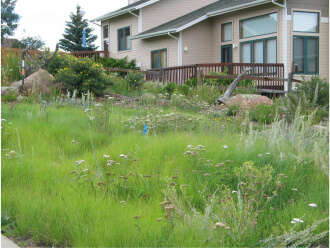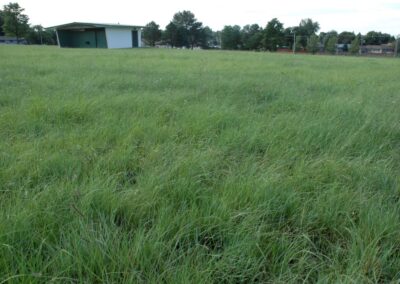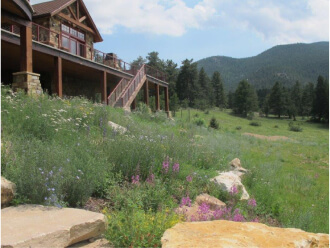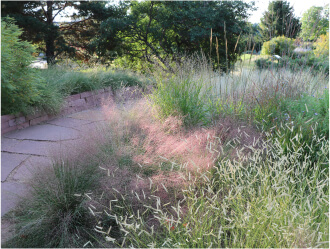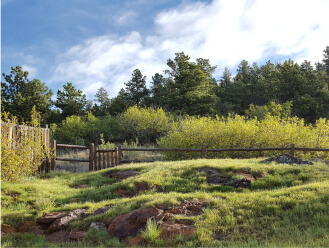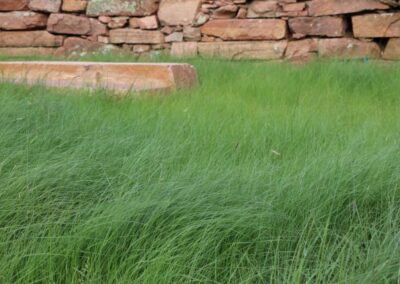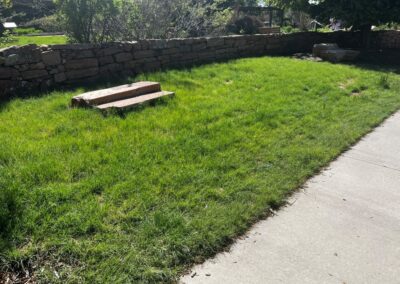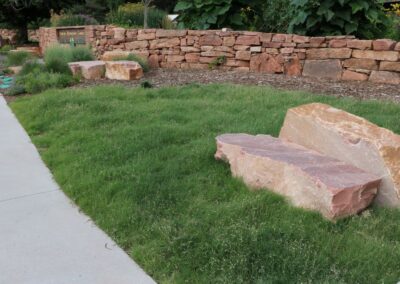Why Native Grass?
A key player in sustainable landscapes of the future
When swapped for turf grass, native grasses can maximize the livability, environmental sustainability, and climate resiliency of Colorado communities. And like any new investment, there is a learning curve to native grasses—they don’t behave like, or require the same inputs as, the turf grasses that we’re used to.
Why take on a native grass project?
Investing in a native grass project can be well worth the effort and resources it requires. Learn about about the benefits these grasses offer.
Water Savings
Native grasses are a low-water alternative to traditional lawn turf grasses. Switching to native grass can yield significant water savings, often ranging from 25-75% compared to traditional turf grass. Along Colorado’s Front Range, Kentucky bluegrass requires about 24 to 30 inches of supplemental irrigation.
Maintenance Savings
Most native and water-wise grasses require less mowing and fertilization. For example, naturalistic prairie grass mixes or blue grama areas can be mowed just once per year and fertilized only during establishment. By comparison, Kentucky bluegrass is typically mowed weekly and fertilized three to four times per growing season.
Resilience and drought tolerance
During irrigation failures, drought conditions, or watering restrictions, native grasses don’t need to be irrigated. If they’re not watered in summer, native grasses may go dormant (turn brown), but will often regrow when irrigation or rainfall returns, even years later.
Environmental Benefits
Planting native grass creates habitats for wildlife, birds, and insects in urban areas, and can help with ecological restoration of disturbed sites. To maximize the environmental benefits of your landscape, choose a mixture of grasses native to your area; the reference plant community in the NRCS Ecological Site Description can be helpful for determining the best grass species for your site.
Community Benefits
Native grasses are an integral part of western-style landscapes that embrace the beauty of native plants and the natural environment. Educating about these grasses creates an opportunity for Coloradans to be better informed about resource stewardship, local ecology, and the value of natural resources. Including native grasses in urban landscapes can also improve water and air quality, sequester carbon, manage stormwater, and moderate urban heat.
Limitations
Valuable as native grasses are, they aren’t right for every project. Before planting native grass, consider how it differs from traditional turf grass:
Foot traffic tolerance
Turf grasses (like Kentucky bluegrass) grow and spread quickly, making them highly tolerant of foot traffic. Many native and water-wise grasses, by contrast, have a bunching growth habit and are best for infrequently trafficked landscapes, like front yards or peripheral areas. Native grasses can work especially well in areas where turf grass may be difficult to maintain, like medians, tree lawns, slopes, and stormwater management areas.
Appearance
Native and water-wise grasses look different than traditional turf grasses; much of Colorado is naturally a grassland, and native grasses can create landscapes that reflect the beauty of Colorado’s natural environment in urban areas. However, because many native grasses are taller than traditional turf grass, have seedheads, or appear less uniform in height, color, or texture, they may be perceived as “weedy.” Education and outreach throughout any native grass project is a critical component of its success.
Maintenance
Using a typical, weekly turf grass maintenance schedule for native or water-wise grass can lead to unhealthy grass and diminish cost savings and environmental benefits. Find our customizable maintenance template for native grasses here.
Shade
Most native grasses need at least six hours of sun per day to thrive. The common native species used today don’t grow well under large trees (especially evergreens) or in the shadow of buildings. Consider mulch or a shade-tolerant groundcover shady spots.
What about Wildfire?
Native grasses can be included in a fire-wise landscape. While they can be flammable when brown and dry, consider these strategies to reduce risks:
- Choose shorter grass species.
- Water periodically to keep grasses green.
- Mow grasses in the fall within 30 feet of a structure or to create a firebreak.
- Prune lower tree branches to manage ladder fuels.
- Avoid mowing as the only strategy to mitigate fire risk.
Learn more about native grasses and wildfire resistance in this publication by Idaho Firewise.
Tidy or naturalistic?
Native grass projects can results in different looks, ranging from low water lawn replacements to naturalistic landscapes that reflect Colorado’s wild beauty.
Seeding just one or two species will create the most uniform look. Mixes with multiple species are best for naturalistic projects.
Think about your preferences before choosing a grass type or mix.
The timeline of a seeding project
Most native grasses are grown from seed, not from the sod that we’re used to with traditional turf grass. Rather than an instantaneous fulfillment of your landscaping vision, this is a process that requires patience over several years—and will be well worth it.
Growth patterns
Colorado boasts more than 300 species of native grasses. They grow in different ways and thrive in different seasons, which will influence the appearance of your sustainable landscape. Learn more about grass terminology to help you make wise choices for your project.
Download the full guide
Our complete native and water-wise grass guide has all the information you’ll need to
get started—from step-by-step project-planning instructions to species-specific planting and maintenance tips. Keep it on hand for easy reference at every phase of your native grass project.

